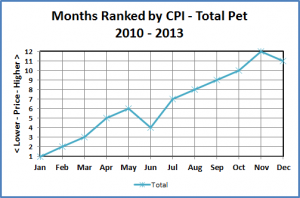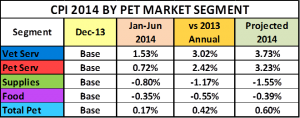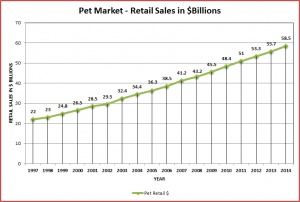Pet Supplies – What is driving the consumer – now?
By late 2010, surveys indicated that 93% of consumers had changed their shopping habits because of the economic downturn. (Time 11/1/12)
- After the recession, 64% of consumers now agree with the statement “Brand names are not better quality.” And it follows that if brand names do not represent better quality, why would it be worth paying more for them? (Time 11/1/12).
- Only 25% of Americans say that brand loyalty impacts their buying behavior. (Forbes 3/26/12)
- Price (89%) and quality (82%) are the highest factors in buying decisions. (Forbes 3/26/12)
- 65% of shoppers note that a high level of variety is an important buying factor.(IRI 8/25/09)
The behavior of a customer/consumer has indeed changed beyond all recognition which means forget what you think you know, forget the past. That’s all gone for good. (Forbes 3/26/12)
In the “prolonged new normal”, “value – encompassing attributes such as convenience, price, health and quality – will win.” Products and brands that deliver a strong value proposition have a better chance for success. (A.C. Nielsen 8/6/14)
The Pet Industry has achieved spectacular growth by building on – not exploiting, America’s growing commitment to our companion animals. In 1989 when I came into the industry, dogs and cats were pets. That is no longer true. Now they are valued members of the family.
We achieved growth through the expanding consumer base, but also by producing ever better products and services – time after time, year after year – New products and improvements that helped enhance the lives of animals and their people “parents”. Healthier, safer, easier…and yes, more fun, these were the driving forces in the industry. It was all about recognizing and fulfilling the consumer’s needs through thought, timely innovation and a concerted effort.
What is the current situation? Since an American household is now twice as likely to have a pet than a child under 18, Pet Supplies are found in virtually every retail channel – Food, Drug, Discount, Club, Sporting Goods, $ Stores, discount clothing outlets…you name it, they’ve got Pet. Not only that, but the major retailers have pet products with their own private label and/or a non-pet related licensed names.
What about private label? This concept first gained real traction in the late 70’s. It started as generic but soon morphed into “store brands” – private label. The appeal was higher margins for the retailers and lower prices for the consumers in products that are bought on a regular basis (commodities). At first, there were quality issues but the consumers taught the retailers quickly. Value = price + quality. The retailers improved the quality and started to expand their private label offerings to a multitude of categories. Remember, they make more money!
How did Pet Supplies get into this private label situation? Consider this:
In 2009, IRI noted that Private label growth is best in commodity-driven categories without a dominant national brand and with relatively low innovation. A specific target category noted in their report was – PET SUPPLIES (IRI 8/25/09)
A variety of research sources have found that consumer buying behavior has changed during and after the recession. I would say that a more accurate way to put it is, “After 40 years of lessons, consumers finally get what we have been teaching them.” Brand does not matter in commodity items.
How did sub-categories in the Pet Supplies segment become commodities? We did it. “Me too” companies marketing products pulled from the same showrooms in China flood the market. Don’t get me wrong. Most are quality products. That’s a major factor. To the average consumer, there is no difference in quality or function between products sold at a pet chain and products sold at a discount department store. If this is the case, then the best price is the best value…and the best choice.
At the same time, true functional innovation has slowed as noted by IRI. If manufacturers must focus on price in an attempt to maintain their current market share, then innovation must take a back seat. It’s also hard for small entrepreneurial creators to get noticed in a flood of products in every category. Policies such as “vendor consolidation” make it even more difficult for unique, new ideas to get to market.
Vendor consolidation is my favorite commoditizing policy. You absolutely can’t argue with it from an accounting viewpoint. It is cheaper to do business with fewer companies! However, you must also believe that all important innovation comes from larger companies. If you look at the history of American business, nothing could be further from the truth. Based upon that, Bill Gates and Steve Jobs should have stayed in their garages. After all, we had IBM for all our computing needs!
Vendor Consolidation is “short term” thinking which can affect the whole industry. Companies would be better served, long term, with creating a “new vendor days” program which makes it easier for inventors to showcase new ideas.
Let’s sum it up:
American Consumers are looking for:
- Value (Value=Price + Quality)
- Convenience (Anything that makes the pet parenting experience easier)
- Selection (Americans need variety, choice)
What do we need to do?
Manufacturers must provide products that meet these requirements and focus on innovation in function and design, Got great products? Don’t rest on your laurels. Make them better – demonstrably. Identify a consumer need and find a way to fill it. Innovation is the only pathway that leads away from “commodity”….However, innovation is not the end of your journey. To reach the consumer, you still need to market your products properly, in today’s environment…
This is definitely easier said than done. I guess we’ll see what “we’re made of”.































